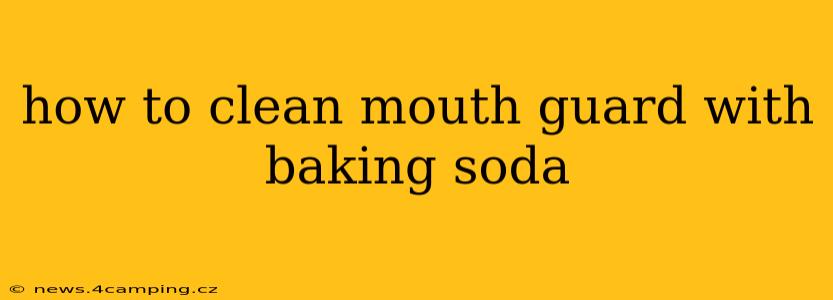Mouthguards are essential for protecting your teeth during sports or sleep, but keeping them clean is crucial for hygiene and longevity. While commercial mouthwash and cleaners are available, many people turn to baking soda for its natural cleaning power and affordability. This guide explains how to effectively clean your mouthguard using baking soda, addressing common questions and concerns.
Why Use Baking Soda to Clean a Mouthguard?
Baking soda, or sodium bicarbonate, is a mild abrasive that's effective at removing stains, plaque, and bacteria. Its alkaline nature helps neutralize acids produced by bacteria, preventing odor and promoting a cleaner, healthier mouthguard. It's also generally safe for most mouthguard materials, though always check your manufacturer's instructions first.
How to Clean Your Mouthguard with Baking Soda: A Step-by-Step Guide
Materials You'll Need:
- Your mouthguard
- Baking soda
- A soft-bristled toothbrush
- Warm water
- A clean bowl or container
Instructions:
- Rinse Your Mouthguard: Begin by rinsing your mouthguard thoroughly under warm running water to remove any loose debris.
- Prepare the Baking Soda Paste: In a clean bowl, mix a small amount of baking soda (about a teaspoon) with enough warm water to create a paste. The consistency should be similar to toothpaste.
- Apply the Paste: Gently apply the baking soda paste to your mouthguard using your toothbrush. Focus on areas with visible stains or discoloration.
- Scrub Gently: Use the soft-bristled toothbrush to gently scrub the entire surface of your mouthguard. Avoid harsh scrubbing, as this could damage the material.
- Rinse Thoroughly: Rinse your mouthguard thoroughly under warm running water to remove all traces of the baking soda paste.
- Air Dry: Allow your mouthguard to air dry completely before storing it. Avoid using a towel to dry it, as this could introduce bacteria or leave lint behind.
What if My Mouthguard Still Smells After Cleaning?
Even with thorough cleaning, some mouthguards may retain a lingering odor. This is often due to bacteria trapped within the pores of the material. To address this:
- Soak it: After cleaning with baking soda, consider soaking your mouthguard in a solution of equal parts water and white vinegar for about 30 minutes. Vinegar's acidity helps kill bacteria and neutralize odors. Rinse thoroughly afterward.
- Use a Mouthguard Case: Ensure you store your mouthguard in a clean, dry case to prevent bacterial growth.
Can I Use Baking Soda on All Types of Mouthguards?
While baking soda is generally safe for most mouthguards, it's crucial to check the manufacturer's instructions before using it. Some materials might be more sensitive to abrasion than others. If you're unsure, it's best to err on the side of caution and use a milder cleaning method.
How Often Should I Clean My Mouthguard?
Ideally, you should clean your mouthguard after every use. This prevents the buildup of bacteria, plaque, and food particles that can lead to odor and potential health issues.
What are Other Ways to Clean My Mouthguard?
Besides baking soda, other effective cleaning methods include using a commercial mouthguard cleaning solution, a denture cleaning tablet, or a mild dish soap. Always rinse thoroughly after cleaning with any method.
By following these steps and addressing potential concerns, you can effectively maintain the cleanliness and hygiene of your mouthguard, ensuring its continued protection and longevity. Remember, regular cleaning is key to a healthy mouth and a long-lasting mouthguard.
